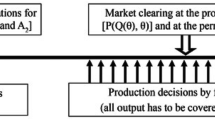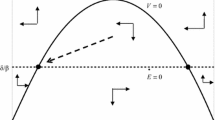Abstract
This paper analyzes the effect of emission permit banking on clean technology investment and abatement under conditions where the stringency of the future cap is uncertain. We examine the problem of heterogeneous firms minimizing the cost of intertemporal emission control in the presence of stochastic future pollution standards and emission permits that are tradable across firms and through time. A firm can invest in clean capital (an improved pollution abatement technology) to reduce its abatement cost. We consider two possibilities: that investment is reversible or irreversible. Uncertainty is captured within a two period model: only the current period cap is known. We show that if banking is positive and marginal abatement costs are sufficiently convex, there will be more abatement and investment in clean technology under uncertainty than there would be under certainty and no banking. These results are at odds with the common belief that uncertainty on future environmental policy is a barrier to investment in clean capital. Moreover, under uncertainty and irreversibility, we find that there are cases where banking enables firms to invest more in clean capital.

Similar content being viewed by others
Notes
These effects would qualitatively remain the same under an infinite horizon assumption, but models of irreversible investment under uncertainty can quickly become intractable under such a more general assumption.
Not necessarily in an optimal way. The cap can result from an international agreement.
That is, we do not specify how it is decided that firm i will get \(A_{1i}\) and \(A_{2i}\).
Recall that \(C_{QQ}(Q_{1})>0.\)
See “Stochastic Case with Binding Irreversibility” section of Appendix 2.
Recall that \(C_{QQ}(Q_{1})>0\)
References
Arrow K, Fisher A (1974) Environmental preservation, uncertainty, and irreversibility. Q J Econ 88:312–319
Cronshaw M, Kruse J (1996) Regulated firms in pollution permit markets with banking. J Regul Econ 9(2):179–189
Durand-Lasserve O, Pierru A, Smeers Y (2010) Uncertain long-run emissions targets, CO\(_{2}\) price and gobal energy transition: a general equilibrium approach. Energy Policy 38:5108–5122
Feng H, Zhao J (2006) Alternative intertemporal permit trading regimes with stochastic abatement costs. Resour Energy Econ 28:24–40
Fischer C, Sterner T (2012) Climate policy, prudence, and the role of technological innovation. J Public Econ Theory 14(2):285–309
Heal G, Kriström B (2002) Uncertainty and climate change. Resour Energy Econ 21(3):211–253
Henry C (1974) Investment decisions under uncertainty: the irreversibility effect. Am Econ Rev 64:1006–1012
Kling C, Rubin J (1997) Bankable permits for the control of environmental pollution. J Public Econ 64:101–115
Kolstad C (1996) Fundamental irreversibilities in stock externalities. J Public Econ 60:221–223
Laffont J-J, Tirole J (1996) Pollution permits and compliance strategies. J Public Econ 62:85–125
Phaneuf D, Requate T (2002) Incentive for investment in advanced pollution abatement technology in emission permits markets with banking. Environ Resour Econ 22:369–390
Rubin JD (1996) A model of intertemporal emission trading, banking and borrowing. J Environ Econ Manag 31(3):269–286
Schennach SM (2000) The economics of pollution permit banking in the Context of Title IV of the 1990 Clean Air Act Amendments. J Environ Econ Manag 40:189–210
Seifert J, Uhrig-Homburg M, Wagner M (2008) Dynamic behavior of CO\(_{2}\) spot prices. J Environ Econ Manag 56(2):180–194
Slechten A (2013) Intertemporal links in cap-and-trade schemes. J Environ Econ Manag 66:319–336
Strandlund J, Costello C, Chavez C (2005) Enforcing emissions trading when emissions permits are bankable. J Regul Econ 28(2):181–204
Zhang F (2007) Intertemporal emission permits trading in uncertain electricity markets. World Bank Policy Research Working Paper 4215, April 2007
Zhao J (2003) Irreversible abatement investment under cost uncertainties: tradable emission permits and emissions charges. J Public Econ 87:2765–2789
Author information
Authors and Affiliations
Corresponding author
Appendices
Appendix 1: Aggregation of Abatement Cost Functions
The abatement cost of firm i reads:
This specification of the individual cost function permits an exact aggregation, such that the aggregate cost function is the envelope of the individual cost functions.
For given levels of aggregate abatement Q and aggregate clean capital K, cost minimization implies that individual abatements and clean capital levels must satisfy the equality of marginal costs:
This is equivalent to:
which immediately yields:
By replacing \(K_{j}\) by \(K_{i}\frac{Q_{j}}{Q_{i}}\) in the first equation of equality of marginal costs, we get:
Then the individual abatement cost is:
which implies, for the aggregate abatement cost:
In addition, aggregate abatement and clean capital are:
Hence,
i.e.
which is Eq. (2) in the text.
Moreover, we easily show that aggregate marginal costs are equal to the common value of the individual marginal costs. On the one hand we have:
On the other hand:
Hence \(\frac{\partial C_{1}}{\partial Q_{1}}=\frac{\partial C}{\partial Q}\) i.e.
which yields
Appendix 2: Resolutions
1.1 Deterministic Case Without Binding Irreversibility
We use the FOCs at periods 1 and 2 collected in Table 1 and the fact that aggregate marginal costs are equal to individual marginal costs.
The equality of the marginal benefit and marginal cost of investment at each period reads:
and yields:
and
The relationship between the permit price at the two periods (the Hotelling rule) yields:
i.e.
The permit market equilibrium is:
We deduce from the Hotelling rule and the permit market equilibrium equation (13) in the text:
When banking is not allowed, the FOCs reduce to the equality of the marginal benefit and marginal cost of investment:
with
They yield:
1.2 Deterministic Case with Binding Irreversibility
FOCs are listed in Table 1. The equality of the marginal benefit and marginal cost of investment when \(K_{2}=K_{1}\) reads:
with obvious notation, i.e.:
The Hotelling rule is:
i.e.:
Hence:
The permit market equilibrium is:
We deduce from the Hotelling rule and the permit market equilibrium equation (19) in the text:
The irreversibility frontier is characterized by:
On the irreversibility frontier we also have by continuity \(K_{1}^{*} =K_{1}^{*\text {irr}},\) i.e.
On the frontier, for \(r=r^{*},\) we get \(Q_{1}^{*}=Q_{1}^{*\text {irr} }\).
When banking is not allowed, the equality of the marginal benefit and marginal cost of investment reads:
with obvious notation. It yields:
To assess the effect of banking, define:
We have:
Moreover, \(h(Q_{1})\) is decreasing for \(Q_{1}<Q_{1}^{*\text {irr}},\) and increasing for \(Q_{1}>Q_{1}^{*\text {irr}}.\) According to Eqs. (51) and (52) on the one hand, (23) on the other hand, we have:
As \(Q_{1}^{\text {wb}}={\overline{U}}-A_{1}<Q_{1}^{*\text {irr}}\) when there is positive banking, we have \(h(Q_{1}^{\text {wb}})>h(Q_{1}^{\text {irr}}),\) which implies \(K_{1}^{*\text {irr-wb}}>K_{1}^{*\text {irr}}.\)
1.3 Stochastic Case Without Binding Irreversibility
The derivation of the optimal abatement and clean capital in the different cases proceeds as in the deterministic case. To avoid repetition and to make comparisons straightforward, we list in Table 2 the first order conditions in the different cases.
The equality of the marginal benefit and marginal cost of investment at each period 2 reads:
as in the deterministic case. Hence:
and
The Hotelling rule is:
i.e.:
The permit market equilibria read:
We deduce from the Hotelling rule and the permits’ market equilibrium equations an equation implicitly giving \(Q_{1}^{\sharp }.\)
When banking is not allowed, the FOC reduce to the equality of the marginal benefit and marginal cost of investment:
with
Hence:
1.4 Stochastic Case with Binding Irreversibility
1.4.1 Irreversibility binding only when the cap happens to be increased
The equality of the marginal benefit and marginal cost of investment reads:
i.e.
The Hotelling rule is:
i.e.
i.e.
from which we ultimately obtain Eq. (37) in the text.
1.4.2 Irreversibility binding regardless of the cap at period 2
The equality of the marginal benefit and marginal cost of investment reads:
i.e.:
The Hotelling rule is:
i.e.:
which is Eq. (42) in the text.
Now we can characterize the two irreversibility frontiers in the stochastic case.
-
The first irreversibility frontier separates the cases where irreversibility is not binding and where it is binding only when the cap is increased. It is characterized by:
$$\begin{aligned}&{\underline{K}}_{2}^{\sharp }=K_{1}^{\sharp }\\&\quad \Longleftrightarrow {\underline{Q}}_{2}^{\sharp }=\left( \frac{1+r}{r}\right) ^{\frac{1}{\alpha }}Q_{1}^{\sharp }\Leftrightarrow {\underline{Q}} _{2}^{\sharp }=\left[ (1+r)r^{\alpha -1}\right] ^{-\frac{1+\beta }{\alpha (\alpha -1-\beta )}}\left( q {{\underline{Q}}_{2}^{\sharp }}^{\frac{\alpha -1-\beta }{1+\beta }}\right. \\&\qquad \qquad \qquad \quad \left. +\,(1-q){{\overline{Q}}_{2}^{\sharp }}^{\frac{\alpha -1-\beta }{1+\beta }}\right) ^{\frac{1+\beta }{\alpha -1-\beta }}\\&\quad \Longleftrightarrow \left[ (1+r)r^{\alpha -1}\right] ^{\frac{1}{\alpha } }\left. {\underline{Q}}_{2}^{\sharp }\right. ^{\frac{\alpha -1-\beta }{1+\beta } }=q\left. {\underline{Q}}_{2}^{\sharp }\right. ^{\frac{\alpha -1-\beta }{1+\beta }}+(1-q)\left. {\overline{Q}}_{2}^{\sharp }\right. ^{\frac{\alpha -1-\beta }{1+\beta }}\\&\quad \Longleftrightarrow \quad \left\{ \left[ (1+r)r^{\alpha -1}\right] ^{\frac{1}{\alpha }}-q\right\} \left. {\underline{Q}}_{2}^{\sharp }\right. ^{\frac{\alpha -1-\beta }{1+\beta }}\\&\qquad =(1-q)\left. {\overline{Q}}_{2}^{\sharp }\right. ^{\frac{\alpha -1-\beta }{1+\beta }}\text { requires }\left[ (1+r)r^{\alpha -1}\right] ^{\frac{1}{\alpha }}>q\quad \forall q\\&\quad \Longleftrightarrow \quad \left\{ \frac{\left[ (1+r)r^{\alpha -1}\right] ^{\frac{1}{\alpha }}-q}{1-q}\right\} ^{\frac{1+\beta }{\alpha -1-\beta } }{\underline{Q}}_{2}^{\sharp }={\overline{Q}}_{2}^{\sharp }\\&\quad \Longleftrightarrow \quad A{\underline{Q}}_{2}^{\sharp }={\overline{Q}}_{2}^{\sharp }\text { with }A=\left\{ \frac{\left[ (1+r)r^{\alpha -1}\right] ^{\frac{1}{\alpha }}-q}{1-q}\right\} ^{\frac{1+\beta }{\alpha -1-\beta }}. \end{aligned}$$As we know that \({\underline{Q}}_{2}^{\sharp }<{\overline{Q}}_{2}^{\sharp },\) it must be the case that \((1+r)r^{\alpha -1}>1\) i.e. \(r>r^{*}\) on the frontier.
The two permit market equilibrium conditions read:
$$\begin{aligned} \left( 1+B\right) Q_{1}^{\sharp }&=\Gamma (q)-(1-q)({\underline{\Delta }}+{\overline{\Delta }})\text { with }B=\left( \frac{1+r}{r}\right) ^{\frac{1}{\alpha }},\\ \left( 1+AB\right) Q_{1}^{\sharp }&=\Gamma (q)+q({\underline{\Delta }}+{\overline{\Delta }}). \end{aligned}$$Eliminating \(Q_{1}^{\sharp }\) between these two equations gives us the equation of the frontier:
$$\begin{aligned} \Gamma (q)=\left[ \frac{1+AB}{(A-1)B}-q\right] ({\underline{\Delta }} +{\overline{\Delta }}). \end{aligned}$$This equation defines \(r^{\sharp a}(q).\) We see easily that \(r^{\sharp a}(1)=r^{*}\) and that \(\frac{dr^{\sharp a}(q)}{dq}<0.\)
On this irreversibility frontier we also have by continuity \(K_{1}^{\sharp }=K_{1}^{\sharp \text {ira}},\) i.e.:
$$\begin{aligned} \left. Q_{1}^{\sharp }\right. ^{\alpha }&=\frac{r}{r+q}\left( \left. Q_{1}^{\sharp \text {ira}}\right. ^{\alpha }+\frac{q}{1+r}\left. \underline{Q}_{2}^{\sharp \text {ira}}\right. ^{\alpha }\right) \\&=\frac{r}{r+q}\left( \left. Q_{1}^{\sharp \text {ira}}\right. ^{\alpha }+\frac{q}{1+r}\left( \Gamma (q)-(1-q)({\underline{\Delta }}+\overline{\Delta })-Q_{1}^{\sharp \text {ira}}\right) ^{\alpha }\right) \\&=\frac{r}{r+q}\left( \left. Q_{1}^{\sharp \text {ira}}\right. ^{\alpha }+\frac{q}{1+r}\left( \left( 1+B\right) Q_{1}^{\sharp }-Q_{1}^{\sharp \text {ira}}\right) ^{\alpha }\right) , \end{aligned}$$i.e.
$$\begin{aligned} \frac{r+q}{r}\left. Q_{1}^{\sharp }\right. ^{\alpha }-\left. Q_{1} ^{\sharp \text {ira}}\right. ^{\alpha }=\frac{q}{1+r}\left( \left( 1+B\right) Q_{1}^{\sharp }-Q_{1}^{\sharp \text {ira}}\right) ^{\alpha } \end{aligned}$$i.e.
$$\begin{aligned} 1+\frac{q}{r}-\left( \frac{Q_{1}^{\sharp \text {ira}}}{Q_{1}^{\sharp }}\right) ^{\alpha }=\frac{q}{1+r}\left( 1+\left( \frac{1+r}{r}\right) ^{\frac{1}{\alpha }}-\frac{Q_{1}^{\sharp \text {ira}}}{Q_{1}^{\sharp }}\right) ^{\alpha }. \end{aligned}$$\(\frac{Q_{1}^{\sharp \text {ira}}}{Q_{1}^{\sharp }}=1\) is an obvious solution of this equation. Hence on the irreversibility frontier we also have \(Q_{1}^{\sharp }=Q_{1}^{\sharp \text {ira}}.\)
-
The second irreversibility frontier separates the cases where irreversibility is only binding when the cap is increased and where it is binding regardless of the cap. It is characterized by:
$$\begin{aligned} {\overline{K}}_{2}^{\sharp \text {ira}}=K_{1}^{\sharp \text {ira}} \Longleftrightarrow (1+r)\left. Q_{1}^{\sharp \text {ira}}\right. ^{\alpha -1}=q\left. {\underline{Q}}_{2}^{\sharp \text {ira}}\right. ^{\alpha -1}+(1-q)\left. {\overline{Q}}_{2}^{\sharp \text {ira}}\right. ^{\alpha -1}. \end{aligned}$$Notice that this equation, valid on the second irreversibility frontier, is identical to the equation that implicitely gives \(Q_{1}^{\sharp \text {irb}}\). Hence \(Q_{1}^{\sharp \text {ira}}=Q_{1}^{\sharp \text {irb}}\) on the irreversilibity frontier, from which we deduce \(K_{1}^{\sharp \text {ira}} =K_{1}^{\sharp \text {irb}}\) (which is also clear from a continuity argument).
We cannot go further specifying the equation of this frontier, \(r^{\sharp b}(q).\)
When banking is not allowed and irreversibility is binding regardless of the cap, the equality of the marginal benefit and marginal cost of investment reads:
and yields:
To assess the effect of banking when irreversibility is binding regardeless of the cap, define:
with \({\underline{Z}}(q)=\Gamma (q)-(1-q)({\overline{\Delta }}+{\underline{\Delta }})\) and \({\overline{Z}}(q)=\Gamma (q)+q({\overline{\Delta }}+{\underline{\Delta }}).\) We easily show that:
and that \(h^{b\prime }(Q_{1})<0\) for \(Q_{1}<Q_{1}^{\#\text {irb}}\) and \(h^{b\prime }(Q_{1})<0\) for \(Q_{1}>Q_{1}^{\#\text {irb}}.\) According to Eqs. (54) and (55), we have:
As \(h^{b\prime }(Q_{1})<0\) for \(Q_{1}<Q_{1}^{\#\text {irb}},\) we have \(h(Q_{1}^{\text {irb-wb}})>h(Q_{1}^{\#\text {irb}}),\) which implies \(K_{1}^{\#\text {irb-wb}}>K_{1}^{\#\text {irb}}.\)
Similarly, when banking is not allowed and irreversibility is only binding for a high cap, the equalities of the marginal benefit and marginal cost of investment read:
and yield:
To assess the effect of banking when irreversibility is only binding for a high cap, define:
We easily show that
and that \(h^{a}(Q_{1})\) is first decreasing and then increasing in \(Q_{1}\). We have:
which is always true as the right-hand side of this equation is negative.
According to Eqs. (53) and (56), we have:
As \(Q_{1}^{\text {irr-wb}}={\overline{U}}-A_{1}<\) \(Q_{1}^{\#\text {ira}}\) is in the increasing region of the \(h^{a}(Q_{1})\) function, \(K_{1}^{\#\text {ira-wb} }<K_{1}^{\#\text {ira}}.\)
Rights and permissions
About this article
Cite this article
Pommeret, A., Schubert, K. Intertemporal Emission Permits Trading Under Uncertainty and Irreversibility. Environ Resource Econ 71, 73–97 (2018). https://doi.org/10.1007/s10640-017-0137-4
Accepted:
Published:
Issue Date:
DOI: https://doi.org/10.1007/s10640-017-0137-4




